
- Text and Photos © Carmen Franco for Eurodressage
Every year in January U.S. based dressage lovers with nationalities from all over the world gather at Mary Anne and Walter McPhail’s beautiful High Meadows Farm at White Fences in Loxahatchee, Florida, for one of the main USDF programs: the USDF FEI Level Trainers Conference.
This year more than 300 people came to the fantastic covered arena to watch Olympians Sven Rothenberger, Sabine Schut-Kery, and retired judge Lilo Fore as moderator, work with eight horse/rider combinations selected from a variety of applicants.
“If you do dressage, you will face a lifetime of criticism"
A quick note before we get to the action: I want to express how much I admire the riders that put themselves in front of all of us to help us learn. As Rothenberger stated, “if you do dressage, you will face a lifetime of criticism.” This is no easy task and I thank them, together with their horses and teams, for it.

Beth Baumert and George Williams
Without a much longer preamble, let’s go directly to what they worked on! Here is part 1.
Forward is a Lifestyle
Bonnie Canter and the 7-year old Hanoverian gelding Vitali (by Vilancio x Jazz Time x Wertschatz) started the day showing a bit of their warm-up. Even though they went around in a beautiful shape and fluent movements, Sabine immediately pinpointed a few lacking details to produce better results. She wanted him to be sharper to the aids, while stressing Bonnie not to sacrifice her position. “Careful not to make the job of the horse, he needs to be more reliable.”
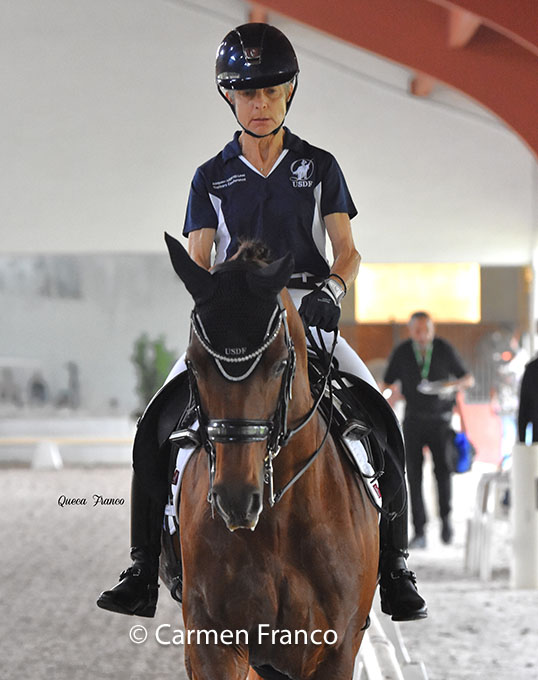
Another movement used to help put Vitali together was the leg-yield in canter from the center line to the track. “When you feel him trying to break to trot from canter, don’t chase him, instead ride a turn or circle so you teach him to bring the hindleg under into engagement.” They also used quarter pirouettes at the walk, and 20-meter circles in shoulder-in. When the collection got better, he wanted to get hesitant maintaining rhythm of the canter, to what Sabine suggested to use the hip to support the leg action but reminded her to keep high standards in her position: long legs, heels down, supple hands. “Forward is a lifestyle” this is the key to everything.
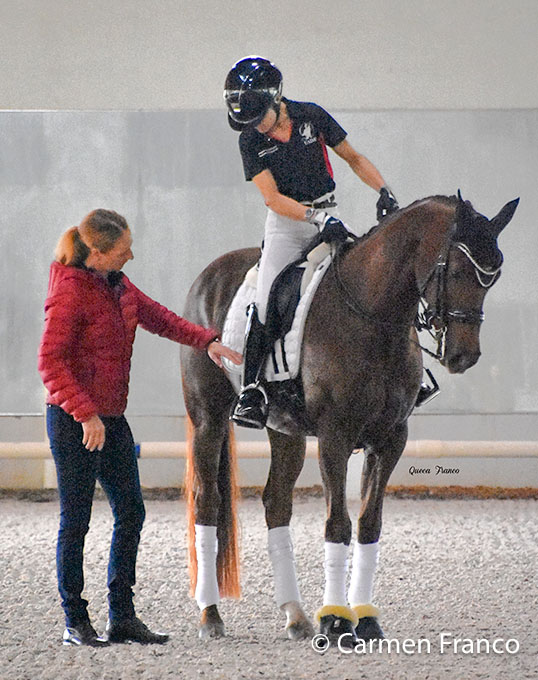
saddle pad on Vitali
And this other quote referred to the same: “produce a thinking horse, not a robot. There must be a partnership.”
Horsemanship Required
Kelsey Dunlap and the 9-year old Hanoverian Heirendale SBF (by Hotline x Rabino x Grannus) were guided by Sabine too. During the warm-up, the horse wanted to be a bit long and quick, so they worked on exercises to help with longitudinal thoroughness and engagement. Changing the tempo at the trot, or riding transitions between gaits, helped articulate the hindleg. A few times Heirendale wanted to overreact to what Kelsey was told, to open the neck, to reassure him with a pat in the neck. “He needs to be comfortable with the challenges.” They went also to work on collecting and going forward in a circle, then into a shoulder in. In the transition from walk to trot, she was asked to think of piaffe to get hindlegs quicker and under, but to be sure he doesn’t move like a marionette, with just the legs going up and down, his body needs to be involved. “It requires horsemanship to know how much to repeat and challenge a horse without drilling and breaking its soul.”

On the second day, he looked more relaxed from the beginning, but they reiterated how important it was to keep finding suppleness with his emotional, claustrophobic reactions. They worked lateral movements at the trot and played with the size of the stride, trying to avoid getting him over stressed. “If the horse is not mentally relaxed, it can’t learn the information given.” Sabine remarked that emotional horses need riders, trainers and owners that can give them the time needed. “Praising is not only giving sugar or patting in the neck, but also quitting movements at the correct time.”

Test Information
During the warm-up, Marjolein Geven on the 16-year old Hanoverian gelding Sir Frederico (by Sandro Hit x Don Frederico) was reminded not to do the job for him and to be proactive with the hands: to let the energy go out without losing the balance. As with the previous horses, they went to open and collect strides, letting the corner help to bring him back and insisting on not letting him shut down. To maintain his activity, they were asked to change the tempo between letter and letter.
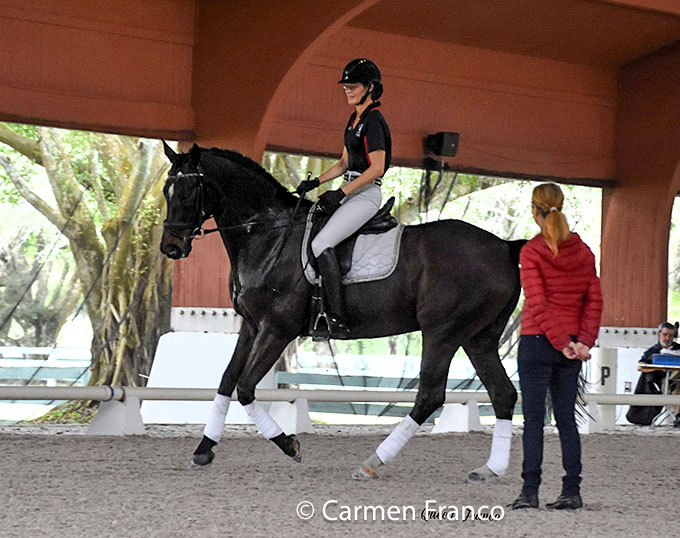
Another important piece of this session was the straightness, meaning that right and left side should be equally available; the hindlegs should follow the footprint of the front legs. The rider must be picky about it as it plays a big role in the collection and the relationship between push and carrying power.
With horses that have “history” it’s better to do 5 good minutes, than going around for longer time with less quality. Raise the bar of your work so you can achieve those good 5 minutes.
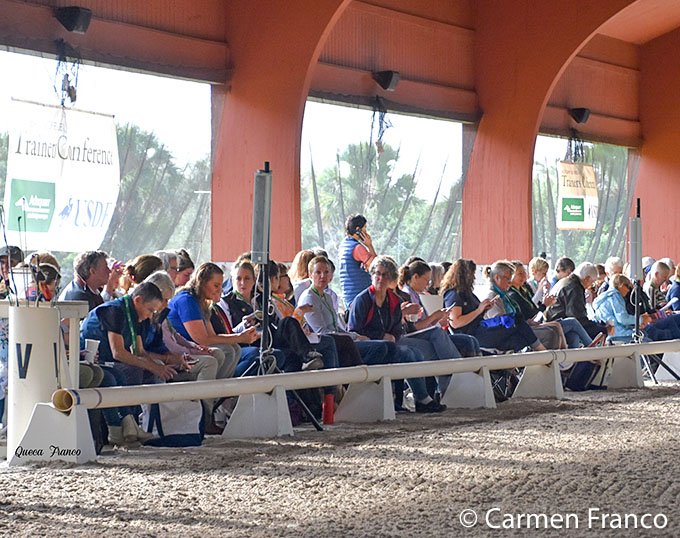
Sabine really took advantage of walk breaks and this time she asked them to perform a 4-loop serpentine to improve the bend on both sides. This lateral suppleness will improve the rideability all around. “In riding tests, the new movement depends on the past one, you better ride everything for an 8!”
Basics, Basics, Basics
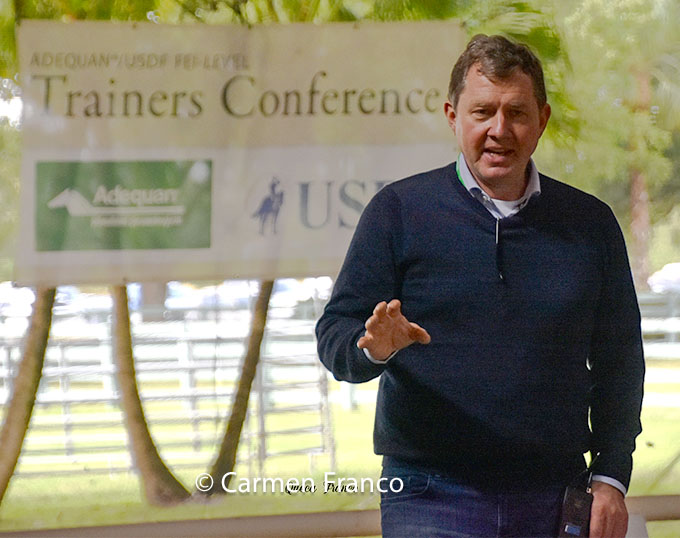
During the trot warm-up, he got the tendency to be behind the leg to what Sven suggested to bump with the leg and let go with the hand at same time. The session went on with lateral movements at the trot and then walk - canter transitions, using lines towards the fence to help them be more defined. Sven joked, “he will not jump out of the ring with that breeding!” Molly was encouraged many times to give with the reins to test and proof the self-carriage and she was reminded to keep him sharp to her legs. “With a horse of this quality, you need to concentrate not to make mistakes.”
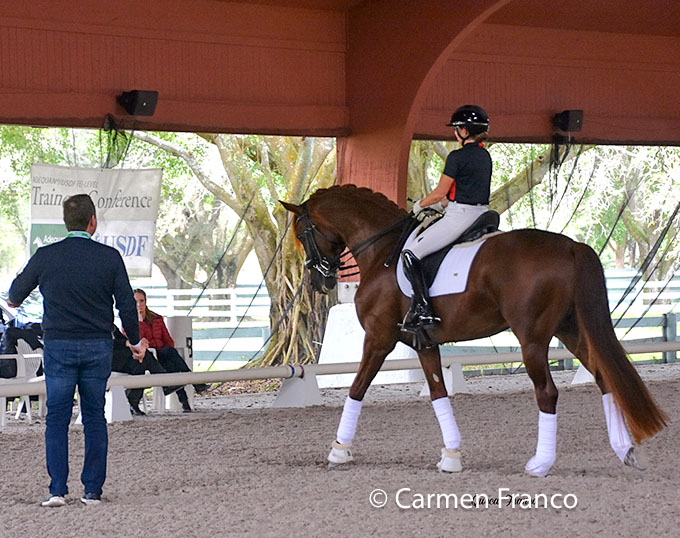
When working on pirouettes, he suggested to school quarter turns as it will be easier to get out of them, than from half or full ones. While correcting details on all they were working on, he advised not to execute movements if the basics are not met.
On the second day, Tuna came with a single snaffle instead of a double bridle. Sven liked the move, saying he thought this was a better option. In this session he really insisted on Molly’s position, to get longer lines out of her body, and not to lean back. “Only through a good seat, you can develop good riding.”
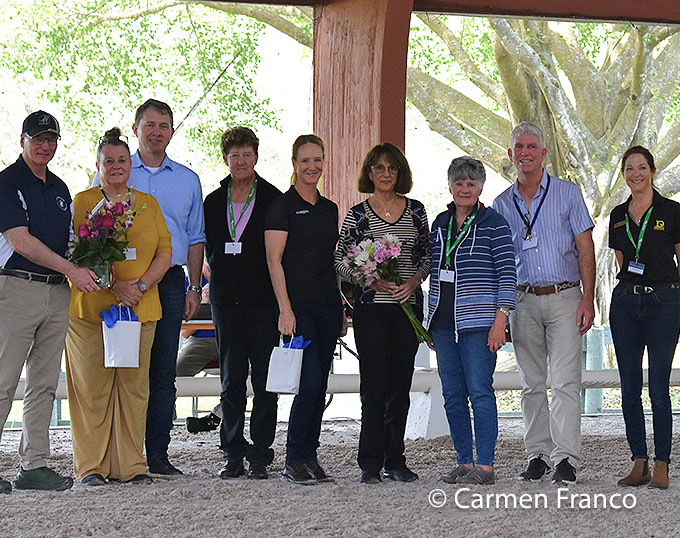
- Text and Photos © Carmen Franco for Eurodressage
Part II coming soon
Related Links
Nuggets of Wisdom from the 2023 USDF FEI Level Trainers' Conference
Carl Hester's Wisdom: "Dedicate Yourself to Get Better, Nobody is Perfect"
McDonald, Traurig, Williams, Bredahl to Speak at 2019 USDF FEI-Level Trainers Conference
2018 USDF FEI-Level Trainers Conference with Johann Hinnemann in Del Mar, California
Demo Riders for 2018 USDF FEI-Level Trainers Conference
Hinnemann and Clarke to Head 2016 USDF Trainers Conference
Stephen Clarke to lead 2015 USDF FEI-Level Trainers Conference
Steffen Peters and Scott Hassler Headlining USDF FEI-Level Trainers' Conference